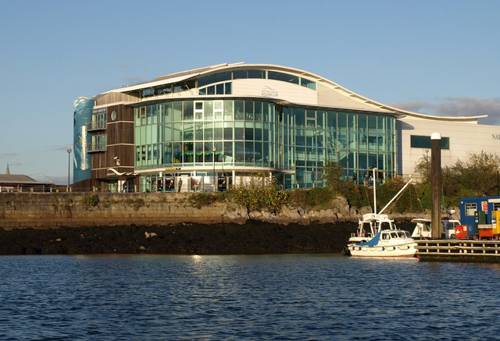
FAQ About Indoor Aquatic Terrarium Design

What is an indoor aquatic terrarium?
An indoor aquatic terrarium is a self-contained environment that replicates aquatic ecosystems within a transparent container, typically glass. It combines land and water features to create a naturalistic habitat that supports aquatic plants and sometimes small aquatic animals. These setups allow people to enjoy a miniature version of nature indoors.

What plants are suitable for an indoor aquatic terrarium?
Suitable plants for indoor aquatic terrariums include aquatic or moisture-loving species such as Java moss, Anubias, Cryptocoryne, and various ferns like the Boston fern. These plants thrive in high humidity and can be partially or fully submerged, depending on the terrarium's design.

How do you manage water quality in an indoor aquatic terrarium?
Managing water quality in an indoor aquatic terrarium involves regular monitoring and maintaining appropriate pH, ammonia, nitrite, and nitrate levels. It is also crucial to ensure proper filtration and aeration, and perform partial water changes every few weeks to prevent the buildup of harmful substances.

What kind of lighting is best for an indoor aquatic terrarium?
The best lighting for an indoor aquatic terrarium mimics natural sunlight and promotes plant growth. LED lights with a full spectrum are generally recommended as they provide sufficient light without overheating the environment. The duration of light exposure should be adjusted to mimic a natural day-night cycle, typically around 10-12 hours of light per day.

Can you include animals in an indoor aquatic terrarium?
Yes, small aquatic animals like shrimp, snails, or small fish can be included in an indoor aquatic terrarium, provided the environment is suitable for their health and well-being. It's important to research each species' specific needs to ensure compatibility with the plants and other design elements of the terrarium.

How can I prevent algae growth in my aquatic terrarium?
To prevent algae growth in an aquatic terrarium, control nutrient levels by avoiding overfeeding and performing regular water changes. Keep the terrarium out of direct sunlight to reduce the risk of algae blooms. Additionally, introducing algae-eating species like snails and certain types of shrimp can help manage algae naturally.

What are the steps to set up an indoor aquatic terrarium?
Setting up an indoor aquatic terrarium typically involves selecting a suitable container, adding substrate and décor, filling it with water, and introducing plants. After initial setup, allow the ecosystem to stabilize before adding any animals. Regular maintenance and monitoring are required to ensure a healthy environment.

How do you maintain humidity in an indoor aquatic terrarium?
Maintaining humidity in an indoor aquatic terrarium involves using a lid or cover to trap moisture, misting the plants regularly, and ensuring the water level is adequate. The use of a hygrometer can help monitor humidity levels, ensuring they are within the optimal range for the plant and animal inhabitants.

What are common challenges in maintaining an indoor aquatic terrarium?
Common challenges in maintaining an indoor aquatic terrarium include controlling algae growth, maintaining water quality, ensuring adequate light and humidity, and balancing the ecosystem's needs. Regular monitoring and adjustments based on observations are necessary to address these issues effectively.

Can I use tap water in my indoor aquatic terrarium?
Tap water can be used in an indoor aquatic terrarium, but it should be treated to remove chlorine and other harmful chemicals before use. Using a water conditioner or letting the water sit for 24 hours prior to introducing it into the terrarium are common practices to make it safe for plants and animals.

How often should I clean my indoor aquatic terrarium?
An indoor aquatic terrarium should be cleaned regularly, but the frequency depends on the specific setup and inhabitants. Generally, partial water changes and cleaning of glass surfaces to remove algae might be required every week or two. A full cleaning is usually necessary only if issues arise or every few months.

What size should an indoor aquatic terrarium be?
The size of an indoor aquatic terrarium depends on the species of plants and animals housed within, as well as the available space and resources. Larger terrariums provide more space for diverse ecosystems but require more maintenance. Even small setups can thrive if correctly balanced and maintained.

Can a terrarium overflow if overwatered?
Yes, overwatering can lead to overflow in a terrarium, especially if there is no drainage system. To prevent this, it's important to monitor water levels carefully and ensure that the substrate and plants can adequately absorb or utilize the water added. Consider using a terrarium with a drainage layer or reservoir to manage excess water.

What temperature is optimal for an indoor aquatic terrarium?
The optimal temperature for an indoor aquatic terrarium varies depending on the species of plants and animals. Generally, a temperature range of 20-24°C (68-75°F) is suitable for many aquatic plants and small animals. It's important to research specific temperature needs for any species you plan to keep.

Are there specific substrates recommended for aquatic terrariums?
Recommended substrates for aquatic terrariums often include gravel, sand, or specialized aquatic soil. Each type of substrate offers different benefits, such as anchoring plant roots, aiding in water filtration, or providing nutrients. The choice of substrate should align with the plants and animals used in the terrarium.

How do I choose the right container for an aquatic terrarium?
Choosing the right container for an aquatic terrarium involves considering size, material, and design. Glass containers are popular due to their clarity and durability. Ensure the container has enough volume to house the desired plants and animals and provides ample space for growth and maintenance access.

Can I use artificial plants in an aquatic terrarium?
While possible, using artificial plants in an aquatic terrarium is not recommended if the goal is to create a self-sustaining ecosystem. Artificial plants do not contribute to oxygen production or water filtration. Live plants provide essential benefits, such as oxygenation, aesthetics, and habitat, that artificial plants cannot.

How do I cycle an indoor aquatic terrarium?
Cycling an indoor aquatic terrarium involves establishing beneficial bacteria to process waste products, primarily ammonia, into less harmful substances like nitrate. This process can take several weeks and usually begins by introducing hardy plants or a small amount of fish food to kickstart microbial development.

What should I do if my aquatic terrarium develops a foul smell?
A foul smell in an aquatic terrarium usually indicates issues like decomposition, poor water quality, or overfeeding. Address this by performing a water change, checking for and removing decaying plant matter or dead animals, and ensuring the filtration system is functioning efficiently.

Are there terrarium kits available for beginners?
Yes, terrarium kits specifically designed for beginners are available and include most necessary components such as the container, substrate, plants, and even some decorative elements. These kits simplify the setup process and provide guidance on creating and maintaining a healthy aquatic environment.
